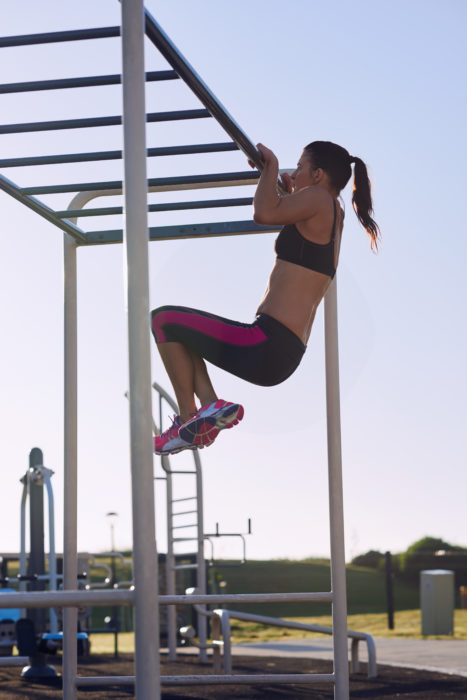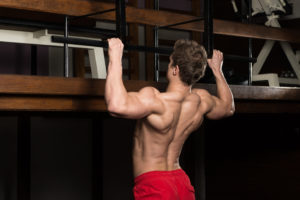So you want to learn how to do a pull up right. Well, the key to a good pull up is activating the right muscles.
See, if you do a pull up the wrong way you’ll end up putting too much of the load in your arms, forearms, and even weird places like your lower back or rotator cuffs (which is bad, in case you were wondering).
The key to doing a good pull up is in activating the proper muscles in your back and your lats.
AKA, backtivation.
Of all the muscles involved in a pull up or chin up, your back muscles are the biggest, baddest, and strongest of the bunch. And those are the muscles you want to focus on in this awesome exercise.
Here are a few tips to help you do just that.
Specific Tips on How to Do A Pull Up
How to Do a Pull Up with… Your Chin

You want your head to be in line with your torso. Don’t tuck your head, because that makes it difficult to fully activate your back.
At the same time, don’t reach with your chin. The most common reason why people do this is because they’re trying to get their chin over the bar.
And that makes sense for a “chin up.” But keep in mind your goal isn’t to reach your chin to the bar…it’s to reach your collarbone to the bar. Keep that in mind and you’ll keep your head in a more neutral position, which will help prevent squeezing in your spinal discs.
Note: if you can’t quite touch your collarbone to the bar, that’s OK. As long as your chin passes the bar it should still count as a rep. Just remember not to reach with your chin, because that will throw you all out of alignment.
How to Do a Pull Up with… Your Chest
You want to lead with your chest on the way up. This will help keep your shoulders back.
The pull up is NOT a completely vertical movement (in other words, you should not be moving straight up and down). Instead, you’re leaning back a little bit while pulling your chest (not your chin or neck) up to the bar.
This will put your legs slightly out in front of you and put more of the load in your powerful back muscles.

How to Do a Pull Up with… Your Shoulders
You want your shoulders to be “set”–in other words, down and back. This helps improve scapular activation, which just means you’re activating the right muscles in your back.
Whatever you do, do NOT let your shoulders roll forward. This is a surefire recipe for shoulder pain.
How to Do a Pull Up with… Your Elbows
You don’t want your elbows going forward, caving inward, or flaring outward. Instead, pull them down and back as you ascend.
Think of it like you’re trying to put your elbows in your back pockets.
This will encourage the proper path of motion. By pulling your elbows back toward your lats, you’ll better activate those big lat muscles.
How to Do a Pull Up with… Your Lower Back
You want your entire torso to be tight and relatively straight, although you should have at least a slight arch in your back. (This is a natural result of pulling your shoulders down & back.)
Just make sure it’s a natural arch. You don’t want to over-arch your back by reaching for the bar.
Squeeze your abs to keep your torso tight and under control. Your goal should be to stay tight and avoid energy leaks.
How to Do a Pull Up with… Your Legs
Keep your legs still. Do NOT use momentum to cheat. This will only stop you from getting the benefit of the exercise.
A common question guys have is, should you keep your legs straight or bend them?
Ideally you should keep your legs straight. This helps you to keep your body tight and neutral. If you’re leaning back slightly and pulling your chest up to the bar, your legs should be just a little bit out in front of you.
However, many pull up bars are too short to keep your legs totally straight. So if you have to, it’s fine to bend your knees so you don’t hit the floor. If this is the case, try letting your legs straighten as you ascend up the bar.

How to Avoid Common Pull Up Mistakes
Pull Up Mistake #1: Cheating or Not Using Full Range of Motion
This is a common mistake on many different exercises. It happens when a guy (usually) gets an ego and decides that he needs to lift a certain amount of weight or do a certain amount of reps. This ego can lead to poor form and incomplete reps.
The problem with doing partial reps is that you don’t get the full benefit of the motion.
And the problem with cheating is you don’t get the full benefit of the exercise, plus you increase your risk for injury.
Just say “no” to kipping and all that other nonsense. Do your pull ups right.
Pull Up Mistake #2: You Don’t Have The Grip Strength
The next time you feel fatigued during a pull up, ask yourself: where do you feel the weakest?
What’s the weakest link in your chain?
For many guys, the weakest link is your grip strength.
You’re pulling a lot of weight in this motion. So if your grip strength isn’t up to par, then your grip is fatigue before your back does.
If this is the case for you, here are a few suggestions:
- Try doing heavy hammer curls.
- Use a grip trainer like Captains of Crush.
- Do deadlifts without lifting straps.
Pull Up Mistake #3: You’re Too Heavy
Unfortunately, there’s no easy fix for this problem.
Because pull ups are a bodyweight exercise, the default load is however much you weigh.
That’s why a 160-pound guy is naturally going to have an easier time than a 250-pound guy. (All other things being equal.)
If weight is an issue, consider following something similar to this protocol on how to get a six pack fast.
Pull Up Mistake #4: Not Setting Your Shoulders

We’ve talked about this all through this article, but it bears repeating. One of the most common mistakes people make doing pull ups is not setting your shoulders.
Each rep should begin by pulling your shoulder blades down and back. (“Depression and retraction” of your shoulders.)
This puts you in a strong position to lift your body using the right muscles.
(Backtivation, baby.)
Pull Up Mistake #5: Not Pulling Your Elbows Down & Back
Say it with me: down and back. Down and back. Down and back.
To activate your lat muscles, you need to pull your elbows toward your lats. Remember, think of it like you’re putting your elbows in your back pocket.